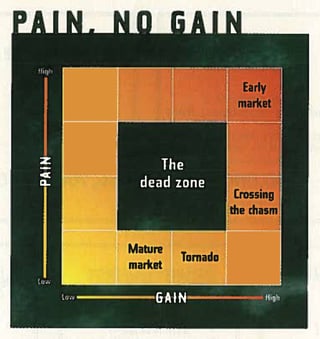
Jun 16, 2016 9:56:40 AM
This post is the fifth in a series on the 5 Common Flaws that Lead to Product Failure. To access the whole message, make sure to read parts one, two, three, and four!
We now get to situations where products are excellent, genuinely brilliant or truly innovative. So much so, in fact, that the audience fails to connect the dots.
These are products that require the customer to take steps they haven’t before to receive the benefits of the new products. Steps that seem obvious to the inventors and product management team, but not so intuitive to the customer.
In his famous book “Crossing the Chasm,” author Geoffrey Moore details how innovations can fall into a product “dead zone” by offering an incomplete solution to a problem:

The Dead Zone is created by products that offer benefits that are require too many hoops to jump through to receive.
How do these products ever see the light of day? It is because there are, in fact, people who will use the products, and wade through the pain to get to the benefits it offers. They are called “innovators” and are extremely tolerant “hoop-jumpers” who will endure the pain to receive the benefits of a new product. However, a group of innovators does not a market make, and there are steps you can take to safeguard against your company developing a product that requires too much education or pain to be a success.
Step One: Decide to Perform Effective Concept Testing Marketing Research
First and foremost, the decision must be made to perform product testing marketing research. Budgeting these tests into the product stage gate approval process is essential from the beginning. However, it is also important to represent the concept properly.
Step Two: Develop a Great Concept Stimulus
The second step is taking care to render the concept as honestly and completely as possible. This means you will have to spend some time with your product development team to ask yourself the following important questions:
-
Why is the product being developed? How will it benefit your customer specifically?
-
What does the product prevent or expedite? (Is it a painkiller or a vitamin?)
-
What are the steps involved in its use?
-
What is the recap in elevator pitch terms?
Check out or post on how to create a great concept stimulus.
Step Three: Be Honest with Yourself
We all know that moment when we realize the product baby we have felt had such promise turns out to be a turkey. For whatever reason, the customers “Just don’t get it.” What is wrong with them? Can’t they see the benefits a mile away like you can?
Before you decide it is still a great idea, get others involved. You may not need an intervention (you may), but admitting the product may be too complex and require significant education is half the battle. At that point, you can at least begin to see the requirements, and make a sober assessment of whether or not the economics of an education campaign make sense for your product baby.
This blog post is the fifth in a six-part series on the 5 Common Flaws that Lead to Product Failure. If you're interested in learning more about these flaws and specific market research methods that can be used to combat them, you can subscribe to our bog to receive a notification when the next piece of the series is published.

